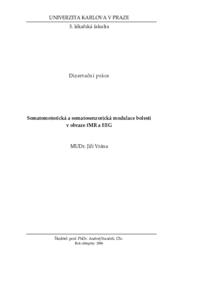Somatomotorická a somatosenzorická modulace bolesti v obraze fMR a EEG
Somatomotor and somatosensory modulation of pain in the EEG and fMR image
dizertační práce (OBHÁJENO)

Zobrazit/
Trvalý odkaz
http://hdl.handle.net/20.500.11956/8396Identifikátory
SIS: 13468
Kolekce
- Kvalifikační práce [3124]
Autor
Vedoucí práce
Oponent práce
Vymazal, Josef
Jech, Robert
Hájek, Milan
Fakulta / součást
3. lékařská fakulta
Obor
-
Katedra / ústav / klinika
Ústav normální, patologické a klinické fyziologie (ZRUŠEN 2015)
Datum obhajoby
12. 2. 2007
Nakladatel
Univerzita Karlova, 3. lékařská fakultaJazyk
Čeština
Známka
Prospěl/a
Zpracování bolesti je na různých úrovních CNS modulováno současně probíhajícími ději. Ze studia nebolestivých somatosenzorických evokovaných potenciálů známe jev hradlování somatosenzorických podnětů pohybem. Klasicky uváděný mechanizmus hradlování v zadním rohu míšním založený na teorii Melzacka a Walla [Melzack R, Wall PD. Pain mechanisms: a new theory. Science 1965;150(699):971-979.] je podle dalších důkazů doplněn ještě nedostatečně prozkoumanými supraspinálními mechanizmy. Podobným nedostatkem porozumění na korové úrovni trpí i metody modulace bolesti interkurentní elektrickou nervovou stimulací. Předkládaná práce se zaměřuje na korové mechanizmy modulace bolesti ve speciálních případech (a) izometrické kontrakce svalů pravé nebo levé ruky při elektrické intraepidermální bolestivé stimulaci pravého ukazováku a (b) při pozorování akutních účinků souběžné nebolestivé vysokofrekvenční mediánové stimulace (PNS) na tonickou tepelnou bolestivou stimulaci thenaru.
Pain processing is modulated at different levels of the central nervous system by concurrent sensory and motor processes. From previous studies with innocuous somatosensory evoked potentials we know of the phenomenon of gating by movement. The classical explanation [Melzack R, Wall PD. Pain mechanisms: a new theory. Science 1965;150(699):971-979.] of the mechanism of gating in the posterior horn of spinal cord is complemented by other, lesser understood data, suggesting supraspinal mechanisms. A similar lack of understanding of the cortical mechanisms is seen in pain modulating methods using concurrent electrical nerve stimulation. This work is intended to further our understanding of the cortical mechanisms of pain modulation in the specific cases of (a) isometric muscle contraction of the right or left hand during painful electrical intraepidermal stimulation of the right index finger and (b) during observation of the acute effects of concurrent innocuous median nerve stimulation on painful tonic thermal stimulation of the thenar eminence.
